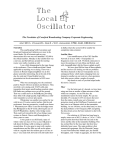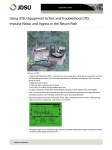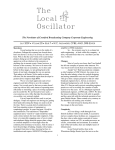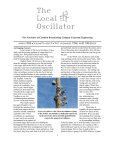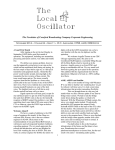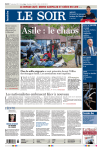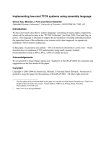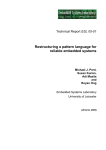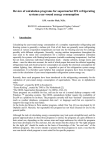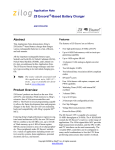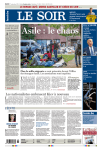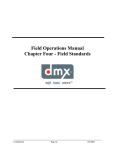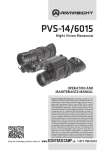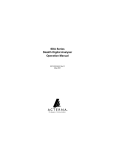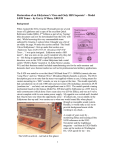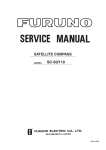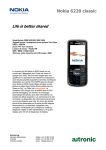Download March 2011 - Crawford Broadcasting Company
Transcript
The Newsletter of Crawford Broadcasting Company Corporate Engineering MARCH 2011 • VOLUME 21 • ISSUE 3 • W.C. ALEXANDER, CPBE, AMD, DRB EDITOR Interference I have, of late, been involved with an AM interference resolution case that I think has application throughout the industry. This particular case involves some stations in Colorado Springs, two of which (1040 and 1530 kHz) are co-owned and diplexed into a single tower, and the third of which is located a few miles southwest. The owner of the third station, which operates on 1580 kHz, is the complaining party. This all started almost a year ago, in May of 2010. The 1580 station licensee began complaining of interference to his station in a fairly small geographic area near the other stations’ site. The local engineers made some measurements and observations but were unable to come to any conclusion other than yes, in some locations near the 1040/1530 site you could hear 1530 station audio on top of the 1580 signal. At the request of the 1040/1530 station owner, I made a trip down to “The Springs” and used our Anritsu Spectrum Master to make some measurements. These measurements clearly showed that 1530 and 1040 were operating well within the limits imposed by §73.44, and there were no measurable third-order products. I took a FIM with me on that first trip and observed that 1040/1530, which both operate with 15 kW daytime, were very strong at the three reference locations I chose. I also observed that the 1580 station was very weak, with nowhere near the field intensity that I would expect. It was so weak, in fact, that the reason for the interference reports became quite clear: the very strong 1530 signal was overloading receivers in the area that were tuned to 1580. It was a simple case of inadequate desired-toundesired signal ratio. After making these measurements, I sent them on to all the parties along with a brief narrative of my observations and conclusion. I heard nothing for several months after that. Then in August, the complaints started up again, so back to The Springs I went. I observed essentially the same thing during that first August trip that I had noted the previous May, that 1040 and 1530 were well within the limits specified in §73.44, that there were no observed third-order products and that the 1580 station was very weak. Prior to making that trip, I did a quick calculation of what the expected 1580 field should be at the measurement points based on M3 (FCC) ground conductivity. I was fairly comfortable with this calculation because the path between the 1580 site and the measurement location traverses the valley around Fountain Creek with no other geological irregularities along the path. Further, I had in years past made measurements in this area and knew that 15 mS/m was a reasonable ground conductivity to assume in that area. The calculation showed that the 1580 field intensity should be on the order of 44 mV/m; I measured 3.5 mV/m. That represents an 11 dB difference, indicative of something seriously wrong with the 1580 transmitter or antenna system. I returned a couple of weeks later and took another look. This time the 1580 field strength at that reference point was 22 mV/m, a big improvement but still 3 dB below what the signal should be in the area. I have no idea what the 1580 folks did, but that signal level was sufficient to provide interference-free reception in the area. The 1530 field strength consistently measured 320 mV/m at that location. I heard nothing else about the situation until last month when the interference complaints started up again. As had been the case in May of 2010, the new complaint was generated when a potential client of the 1580 station would not sign an airtime contract because the 1580 signal was not clear in the area around his place of business. The 1580 station engineer was making noise about a provision of §73.44 requiring 1530 to install additional filtering 1 The Local Oscillator March 2011 because of this interference. Based on my prior experiences, I knew that additional filtering would be worthless because the “interference” was being generated in the front-end of listeners’ receivers and was not the result of out-of-band emissions from 1530. Before I would agree to grab the FIM and SA and head back down to Colorado Springs, I asked the 1580 station engineer to provide me with some measurements. I asked for seven close-in measurements on the 1580 radial of interest, and I asked for field intensity measurements at the three reference points I had been using (one of which was in a large mall parking lot across the street from the client’s place of business). So far I have heard nothing else. I suspect that the engineer found that 1580 continues to have transmitter or antenna problems and that the station’s field intensity is very low in the area of interest. While the final chapter in this story has yet to be written, there are some lessons that we can take from what we know so far. The first (and perhaps most important) is to be sure your own house is clean before complaining about interference from someone else. This point was driven home in recent months in two separate listener complaint episodes. In one, a woman who lives near one of our transmitter sites was complaining that she could not hear her favorite station, which is 90 kHz above our station. She was certain that we were the problem, but some field measurements and a phone call by our engineer confirmed that the other station was having some tower work done and was operating at reduced power. Once full power was restored, normal reception was restored. In the other case, the issue was a noisy power supply in a cable box. It was wiping out AM reception in a listener’s house. Our engineer (Amanda) advised this elderly listener how to troubleshoot the problem (turn off circuit breakers one at a time while listening to a battery powered radio) and this procedure quickly showed up the problem – again, not ours. Down in Colorado Springs, the problem has historically been low signal strength from the complaining station, and I strongly suspect that it is again. My advice to any station engineer trying to sort out an interference problem would be to start at your own transmitter and make certain that the power is correct and that it is being radiated. You’re going to be embarrassed if you make an allegation and find out that the problem was your own all along. Another lesson is that there is no substitute for empirical measurements. Oftentimes, interference complaints are backed up with only anecdotal evidence. Measurements tell the story. Spectrum analysis in both AM and FM interference cases and field intensity measurements in AM cases are invaluable tools. Are emissions what they should be, within the FCC-specified emissions mask and free of harmonic and third-order products? Finally, good engineering sense must be used when evaluating an apparent interference situation. Several years ago, our KBRT began experiencing interference across a five mile wide swath in the Burbank area. The interference took the form of noise (“hash”) and it sounded for all the world like weak signal. A little sleuthing revealed that Disney’s KSPN (50 kW and 30 kHz below the KBRT carrier frequency) was in the center of the “weak signal” area. A little more sleuthing and analysis of the facts and it wasn’t a great leap to come to the preliminary conclusion that we were actually hearing third-order IM products from the KSPN HD Radio operation. These were 65 dB or better below the KSPN carrier, but 50 kW is a lot of carrier! KBRT had about 5 mV in that area but the KSPN IM products were in the 1 mV range in the affected area. I called Clay Steely over at ABC/Disney and arranged to try a little experiment wherein KSPN would reduce the level of its lower digital carriers by 2 dB. That did the trick, reducing the IM products by about 6 dB and reducing the “hash” to a level where it was no longer objectionable. A little sleuthing and the application of some engineering sense provided a good, working hypothesis that was the basis for a quick resolution. The first radio interference case in history no doubt occurred when the second transmitter took to the air, and we have been battling interference ever since. It’s a fact of life in the broadcast business, something we have to deal with from time to time. If we start with a clean house, obtain good empirical data and apply good engineering sense, we can work through most interference issues in a hurry. 2 The Local Oscillator March 2011 The New York Minutes By Brian Cunningham, CBRE Chief Engineer, CBC – Western New York Hello to all from Western New York! In last months edition of The Local Oscillator, Art Reis pointed out the difficulties he has experienced in obtaining replacement parts for Sony and Denon broadcast equipment. From what I am told by those in the broadcast equipment sales end of the industry, parts availability closely coincides with the amount of sales of any given product. From what I am told, as an example, if a CD player is manufactured to the tune of 100,000 units, then the maximum replacement parts per item/per unit is, at best, ten percent of the overall manufacturing run, or 10,000 units. If the unit has a high sales demand, then replacement parts availability is kicked up to fifteen percent of overall production run and kept at that level for 24 months. After the first 24 months has elapsed, if the replacement parts demand for that product has dropped, or the unit has been re-designed or dropped from production altogether, the availability of replacement parts drops from 10 percent to a little over 4 percent. In some cases, any remaining parts designated as replacement parts are integrated back into the manufacturing facilities and used, when applicable, in the manufacturing of other equipment. Those parts that do not make it back into the manufacturing bins, are usually sold at bulk to electronics wholesalers or other manufacturing plants that have a need for that particular item. The reasoning behind this is that the manufacturing plants do not want (and cannot afford) tying up millions of dollars in parts inventories that may or may not deplete themselves in two years or less. It’s all economics, and finding a way to keep corporations profitable. Some facilities, such as Sony, will set up repair and parts facilities in companies outside their corporate structure to supply customer services such as parts and repairs. These facilities are independently run and operated companies, and in some cases they even employ former engineers and repair/rebuild personnel from the manufacturing plants. They have found that the cost of warehousing replacement parts for all manufacturing runs, the labor costs for repairs, and maintaining the required stable of test equipment and support staff, was just not worth it and that there was not enough profit to be made in the parts and repair business. It just about makes most of the lower priced equipment “throw away” items. I know for a fact that the television manufacturing industry has come to this. My dad, who owned a TV sales and service business for 60 years, has seen that industry go from a full parts supply to modular board replacement to “fix it if you can find it” cross-referenced parts or throw it away. The initial cost of the televisions has dropped considerably due to a number of things, but mostly it’s due to cheap labor and parts from China. Many of the components in electronic equipment are only assembled here in the US; the bulk of the manufacturing and labor costs are at Chinese rates, which are way lower than any US owned and run manufacturing facility could beat. Even with shipping costs to the assembly plants added to the overall manufacturing costs, China has found a way to produce items and make money, far below what any US competitor could do. In a nutshell, it sometimes would be a good idea, when buying a number of the same item (such as a CD player) to purchase one additional player to keep on hand when parts are needed to fix one of them. You may think this is going to the extreme, but look at it this way: the initial cost of a cheap rackmount CD player is about $150; a replacement optics assembly − if you can find one − would run around $75, or half the original investment. A loading motor tray assembly would set you back about $90. These are two of the most replaced items in a CD player 3 The Local Oscillator March 2011 (not counting the cheap control buttons on the front panel). It’s not that these two items cost that much to produce − if that were the case, you would be spending a whole lot more to purchase this particular CD player; the cost is in the inventorying and shelving of the replacement parts. Supply and demand also play a large role in the pricing of replacement parts, usually the bigger the demand, shorter the supply and the higher the price. That’s good old US economics! diversity delay turned off in the FSi-10, it was adding delay to the analog signal! Another call to BE with additional information resulted in the same response − they had never encountered this problem before. Their solution was to re-install the software to see if that took care of the problem. I did not have on CD the version we were running (v2.4.2) but it was available for download off the BE website. I downloaded the software and reinstalled it on the FSi-10. As of this writing it has been five days since the last alarm; I have not seen any problem. The delay is still set exactly as I left it and I have received no alarms from the Burk. It’s strange, too, that I was receiving a high/low output power alarm from the transmitter. I don’t know if the power was momentarily spiking and dropping, as it never happened when I was at the site and in front of the transmitter. I am hopeful that the software install did the trick, but am still curious to know what actually was causing this. On the Rochester side of things, there’s not much to report on from WDCX(AM). Things have been running smoothly there, with no breakdowns or anomalies to report on. On the FM side of things, we recently had NexGen install the “WANcasting” modules on WLGZ-FM and WPTR in Albany as well as one of Don Crawford, Jr’s stations in Colorado Springs. Aside from Internet bandwidth issues, especially on the upload side, things there seem to be working okay. This is a new side of NexGen that I was not familiar with, so I will be working closely with Mark Shuttleworth in Rochester to learn all I can about how this works. We had received several complaints about interference to our broadcast signal in Wayne and Ontario counties recently, so this past Saturday I spent much of the day traveling around the reported areas receiving the interference from 102.7 near Watertown, New York. I did not find any indication of a problem, and will chalk this one up to atmospheric anomaly unless the complaints continue. WDCX–FM • Buffalo, WDCX(AM)/WLGZ–FM • Rochester Not long ago, I reported about an anomaly in the Burk remote control for WDCX-FM. I was receiving random alarms on channel #7 which is our BE HD-R transmitter. The alarm would state that the HD transmitter power was above the upper limit followed by another alarm that it was also below the lower limit. An immediate check of the readings would show everything normal. I re-punched the remote control wiring on the punch blocks and everything seemed to quiet down for a number of weeks. Then it came back again with the same symptoms, but I noticed that every time I got these alarms, the diversity delay was off between the analog and digital signals. I would make the necessary adjustments in the Omnia audio processor to get the delay matched perfectly, and two to three days later, I would get this alarm and the delay would be off by at least a second to one and one-half seconds. Again, I would adjust the delay, and a couple days would go by, and again, the same alarms and the delay is way off. A call to BE tech support revealed no possible solution; they have never heard of this problem before. They suggested setting the diversity delay in the FSi-10 instead of the Omnia 6 Ex+HD. I was not too keen on this. For one thing, it takes forever to set the delay in the FSi-10, and the delay has been working fine for years using the Omnia. After several rounds of adjusting and readjusting the diversity delay, I came upon a startling discovery. If I re-booted the FSi-10, the delay would come back to within a few mS of the previous adjustment. This meant that somehow, even with the That about wraps up another month here in the great northeast, and until we meet again here in the pages of The Local Oscillator, be well, and happy engineering! 4 The Local Oscillator March 2011 The Motown Update By Joseph M. Huk, Jr., P.E., CPBE, CBNT Chief Engineer, CBC–Detroit Mother Nature has sure been rough on us here in the Detroit. We not only received over a foot of snow in some parts of the area at the beginning of the month, but just recently we endured a very nasty ice storm. The combination of snow and freezing rain/ice created a very heavy load on overhead power lines and some communications equipment. In fact, as I write this article, we are on generator power here at my home. We have been on generator power for a week now. At the station, we didn’t really suffer any major issues due to the storm, but we did get some really tough ice and snow buildup on one of our Cband satellite antennas. Just the other day, I noticed that our Unity satellite receivers were not working and indicated a low RF level. I went outside and noticed that there was some buildup of snow and ice on the dish that accumulated from the recent storm. At first it did not seem like a significant amount of build up. I believe it was the location of the accumulated ice that had such a significant effect. It built up at the center of the parabola, and therefore must have affected the geometry of the dish enough to distort the focus of the beam at the feed horn and LNB. There was no noticeable build up on the feed horn. It took a shovel, not a broom, to clear the buildup due to the hard nature of the ice. After it was cleared away, the signal strength was restored to normal. It surprised me just how small an amount of ice on the dish could affect its performance. We have two of these Patriot C-band dishes in Detroit. We use one to receive many different show feeds using the Unity receivers. The other is primarily used to receive Dave Ramsey and Heatlhline on the Citidel (formerly ABC) satellite services. Hmmm… I may be wrong, but I wonder if it is now all owned by Cumulus? Our broadcast community is always in flux. It is sure hard to know who’s on first. Incidentally, I was talking to Jack Lemon, one of the knowledgeable service engineers at DawnCo (satellite equipment supplier) here in Michigan. He told me that those Patriot dishes I have were made right here in Adrian, Michigan. Adrian Michigan is my home. From what I understand, Patriot sold to a British company. All of the dies that make the dishes went back to the UK It is always sad to see high tech manufacturing leave our country. Last month I mentioned we were implementing the new Sage Digital ENDEC units. Right after the L.O. hit the virtual presses, I received a nice note from Harold Price with Sage, a regular reader of these pages. When you enter email addresses into the new unit, you old need to put each email address on a single line. You really do not need the semicolon to separate the addresses. In addition, I understand that Harold is working with RCS (NexGen) to design a routine to allow commands to be sent via IP to the Sage. This will make integrating weekly tests within our NexGen logs very easy. Harold, thanks so much for the information. After the hardware was installed, I programed the new Digital ENDECs to send email alert confirmations. Then I created a rule within my Outlook program to print the logged alert or activity to a local printer. This email can now be attached to our EAS/operating log for FCC compliance. The rule also moves the email to a folder labeled for the station in question. Very cool! Until next time, be safe, and if all goes well, we will be reporting to you from the pages of The Local Oscillator next month. Best regards. 5 The Local Oscillator March 2011 News From The South By Stephen Poole, CBRE, CBNT, AMD Chief Engineer, CBC–Alabama Yet Still More Global Warming We had yet still another big snow in early February. I can’t recall when Alabama has gotten three significant snows in a single season. Of course, all things considered, we got off lightly. Aside from some icing on our FM antennas and a few days of restricted travel, we made it through okay. Second Assistant Jimmy Parker had it the worst of the Birmingham engineering team; he lives in Huntsville, and there are two bridges that he can use to get to Birmingham. As soon as they ice up, he’s stuck in Rocket City until they’re cleared. The news elsewhere has been filled with stories of travel delays, closed airports and stranded motorists, even Up Nawth, where they’re supposedly better equipped to handle the white stuff. To be fair, I guess even the most experienced highway department or airport maintenance crew is going to be stumped by a couple of feet of snow in less than 24 hours. But I agree with one editorial that I read recently claiming that this winter should be the death knell for Anthropogenic Global Warming. The AGW alarmists have frantically tried to point out that temperatures elsewhere went up to compensate (which is debatable), or that Global Warming itself caused the record-breaking snowfalls (ditto), but nobody’s listening. Amazing what a little snow can do, huh? As I’ve said here before, I’m not an Expert (capitalized in sheer irreverence), but I can think for myself. Even if temperatures are trending upwards (and that’s also debatable), there’s just not enough evidence to convince me that it’s caused by mankind. I think it’s due to normal solar cycles. Again: I’ve read some convincing arguments, based on solar observations, that we’re actually moving into another Little Ice Age. But what do I know? Breathing New Life into an Old Comstream As I’ve also said here before, a lot of the equipment we use in broadcasting is manufactured by something resembling a cottage industry. There simply isn’t a large enough demand to justify the usual mass production techniques that are used on automobiles and television sets. Things like audio processors and transmitters are essentially built one at a time by technically skilled personnel. This makes the stuff more expensive, of course, but hey, that’s how economics works. The good news is that we can get what we need to do our jobs. The bad news is that we often get stuck with old designs that continue to be sold simply because the manufacturer can’t justify updating them. Our Comstream Ku-band satellite receivers, especially the older ABR-200s, are a great example. If you’ve looked inside one, it uses TTL and CMOS logic “glue chips” to tie everything together instead of the much more common “one chip does a dozen things” of more modern designs. The processors even have separate ROM chips for the program memory, where virtually all modern units have the software burned (or flashed, nowadays) into the processor itself. The biggest problem with these Comstreams is that they run quite hot, especially the older 200s. We had one years ago whose Eb/No would deteriorate the longer it was in operation; we solved that by putting a fan on the case. That told us right away that we had a heat problem. A look inside the unit showed why. First, in my opinion, that dinky little power supply is simply inadequate for the demand, and second, there are series regulators on the motherboard that radiate heat as well. That unit really ought to have an exhaust fan on it, but relies on simple convection for cooling. Heat is the enemy of electronic components, especially of capacitors. Even if a unit is just very 6 The Local Oscillator March 2011 warm to the touch, it could be considerably hotter inside. This matters in digital audio because power supply filtering tends to become less effective at higher temperatures. A noisy power supply will result in a lower Eb/No in a digital receiver. You might replace an LNB and re-tweak the dish a couple of times only to still have an Eb/No figure that varies wildly from one day to the next. If everything else seems to be working normally, and (here’s the kicker!) another receiver on that same dish seems to work fine, then speaking from personal experience, the very next thing I’ll check is the power supply. These old Comstreams still work, they meet our needs and we’ll probably continue using them for several more years. But take my word for it, you will replace that power supply eventually. Even though it’s a fairly-efficient switching type, it still gets quite hot. I’m sure you’ve pulled one and have noted how brown (or even black) the PC board can get after just a few months of operation. The original supply is sometimes difficult to find. It’s from “Y K Systems” (the YK stands for “Young Kim”), a small manufacturer/importer that apparently specializes in custom and one-off work. When you can find a replacement, it’s likely to be expensive, too (several hundred dollars). An additional difficulty is that we don’t actually have a service manual or a schematic, so we must extrapolate and calculate the demand. We decided to play it safe and overcompensate. The original supply has four outputs: +5V for the logic, +/- 15V for the audio and +24V for the LNB and the main converter/detector assembly. Our candidate was an old ABR-200 that tried to work but had a low Eb/No. We decided to replace with two separate units: a 5V, +/- 15V 3-output and a single +24V output supply. The larger of the two supplies (the +5, +/15) fit into the original location, but we had to put the separate +24V LNB supply in the available space near the front of the unit. (One of our ABR-200s have holes drilled up there, making me suspect that some of them, at least, came with two separate supplies as well.) Todd drilled a couple of holes and mounted it securely “in front” of the main supply. See Figure 1. The replacement main supply is taller than the original, so we had to cut a hole in the top cover. This isn’t difficult; we were able to do it with a snipper and a chassis nibbler. A grinding wheel polished up the rough edges and we then put an aluminum screen (purchased at Lowes) to protect personnel while still permitting ventilation. The final touch was a small blower atop the screen to exhaust the heat. Instead of getting uncomfortably hot now, the case is barely warm to the touch. Figure 1 - Mounting the two supplies in a Comstream ABR-200 Figure 2 - A cooling blower is added to exhaust the hot air And did it help? Before the supply replacement, our Eb/No was about 5.5; after replacement it went up to 11.5! Yes, it made a huge difference. During the horrible ice and snow earlier in the month, our Eb/No would routinely drop below 5, causing dropouts and digital glitches in the audio. Now it’s rock-solid and clear as a bell. The Audio Files: The Distortion Wars How old am I? I’ll tell you how old: I can remember the Distortion Wars, which were preceded by the Power Wars. Back in the late 70s and early 80s, companies like Pioneer and Sansui began 7 The Local Oscillator March 2011 producing receivers with higher and higher power ratings. The FTC stepped in and required standardized procedures for measuring power output; before they did that, you’d routinely see small tabletop radios at the drugstore that bragged of having “200 WIPP!” (Translated, that’s “200 watts Instantaneous Peak Power,” which figure is apparently derived by the absolute maximum possible peak power available from the power supply, even if it results in the thing exploding like a bomb.) Then they changed tack: Yamaha ran an ad that said, “While everyone else has been increasing power, we’ve been reducing distortion.” Whence began the Distortion Wars. Other manufacturers followed suit, and you had ads boasting of “.005%,” then “.002%” and even “.001% total harmonic distortion.” The high-end audio shop that I worked for at the time had to purchase a very expensive new audio analyzer just to be able to confirm these values. Back then, existing test equipment was doing quite well if it could measure .1%. You have to give them credit: the designs were engineering marvels. Even with tons of negative feedback, it’s difficult to get distortion figures that low. When repairing these units, we couldn’t use generic replacement transistors, either; we needed carefully-matched, factory-supplied components, or the distortion would creep up. I remember one case where we replaced a set of outputs with inexpensive 2N3055s, only to see the distortion rise from the specified .05% to about .2%. To avoid complaints and lawsuits, we had to confirm that any repaired unit met the original specifications, so we had to remove those ‘3055’s and put in the original parts. Besides, THD is only part of it. There’s also frequency response, intermodulation distortion (IMD), transient intermodulation distortion (TIM) and of course, hum and noise to be considered. All of these contribute to just how “clean” a given amplifier might sound. And here’s a fact that even many audiophiles apparently don’t know: the average speaker system has gobs of harmonic distortion, especially at deep bass frequencies, where figures of 10-20% are common. But nonetheless, some snooty audiophiles insisted that they could hear the difference between .01% and .005% THD. No doubt, these same types of people today will spend thousands of dollars on “oxygen-free, pure spun copper” cables, equally convinced that they make a difference. Some of the old tube audio amps from the 50s had very respectable THD figures; McIntosh and Scott produced amplifiers with .5% or less. But the IMD was another matter entirely. Even with as much negative feedback as they dared employ (hard to do with a transformer in the circuit), the best IMD figure I ever saw on one of these amps was in the 1-3% range. Tubes aren’t linear and non-linearity equals intermodulation distortion. It’s just that simple. But back to the distortion wars, which actually only lasted for a few years. No one was talking about psychoacoustic masking back then; the term wasn’t even on the radar. Even .5% THD represents harmonic products that are about 46 dB below the main program, which are thus inaudible in real life. But hey; it made for great advertising − or at least they thought it did. Eventually, once they realized that it wasn’t causing a flood of new sales, the manufacturers moderated their claims. They decided to add features and to save a little money on the power amp instead. Distortion crept back up into the .05% to .5% range, where it generally lives today. But it was fun (and funny) while it lasted. Until next time! Continue to pray for this nation! 8 The Local Oscillator March 2011 Catalina Tales By Bill Agresta Chief Engineer, KBRT Greetings from Santa Catalina Island! February was relatively calm vis-à-vis the island factor, but we continue to work on projects to stabilize things here as much as humanly possible. We have ordered Burk’s AutoPilot software to operate our transmitter to take some pressure off of me, since I have been running it manually since time began here. I am also going through all our UPS units, replacing batteries and preparing for our last couple of years here on Catalina Island. At the same time our new Blackstar Canyon site is coming along nicely. We have just installed a new gate that we hope will make a major difference in securing our property, and I continue to research other security options to help us get rid of the vandals that have been hanging around that property for many years un-policed. The more we work at this new site, the more I realize its advantages over our current island transmitter site, and the more I am growing to love it. We still have many challenges ahead, but with God’s help we trust things will continue to move forward in an orderly fashion. On a personal note, as I have been working more and more in the “real world” (on the mainland), I am coming to realize how islandized I have become, living on that rock cut off from reality as most know it for about 20 years. I find myself in awe as I see how much worse traffic has become since I left the Los Angeles and Orange County areas and especially how much people’s attitudes have changed for the worse. The frustration level in the city is quite high it seems, and people do not seem to be enjoying much of anything. I pray each day that God continues to fill me with His joy and gives me the strength to serve Him. After seeing the frustration on the streets over the past few visits, I have begun praying a lot more for others as well, who so obviously need Jesus. As I write this, we are preparing for freezing weather as snow is expected all the way down to the five hundred foot level. I am told it has been some sixteen years since we had a lasting amount of snow up here, but if this storm plays out the way it has been reported, you just might see some pictures of me skiing the tower field in next month’s Local Oscillator. Until next month, the Lord bless you and keep you; the Lord make his face shine upon you and be gracious to you; the Lord turn his face toward you and give you peace. New gate at Blackstar Canyon site 9 The Local Oscillator March 2011 The Chicago Chronicles By Art Reis, CPBE, CBNT, AMD Chief Engineer, CBC–Chicago Single Sideband FM Stereo Subcarrier? Would you believe that the FM Stereo standard is 50 years old this coming summer? And, would you believe that it is the only broadcast standard which has had virtually no changes in all that time? Think about it: AM has gone through changes in frequency response standards, and the Motorola AM stereo standard has come and more or less gone (I know of several stations still using it!). The old NRSC colorTV analog standard is now gone, and even it had changes across the years to its VITS standard (oh, picky, picky!). But FM stereo is still using the “15 kHz maximum audio frequency/19 kHz pilot/38 kHz double sideband suppressed carrier” standard that Zenith Radio and General Electric dreamed up in 1960 and which debuted in Chicago on WEFM in 1961. Boy, how time flies, and how long that standard has both served us all well, and just lasted, unchanged − until, maybe, now. The change I’m citing is to the L-R subcarrier, and frankly, it’s a wonder this one hasn’t come about before now. Frank Foti, the inveterate inventor of the Cutting Edge Omnia series (1, 3, 5, 6, and now 11) of audio processors brought this up at a recent SBE Chapter 26 meeting in Chicago. He even has a white paper on the omniaaudio.com web site; the full link is below. I’m only going to give a thumbnail sketch here. My goal is merely to spread the idea more widely. Read Frank’s white paper for the full skinny. Anyone who’s ever held an Amateur Radio license of any kind knows of single sideband (SSB) radio transmission. SSB first came into its own during World War II as a way to improve the spectral efficiency of military communications. Art Collins of Collins Radio was an early pioneer of the mode. Amateur Radio picked up on SSB after the war was over, and it soon vanquished traditional AM on the ham phone bands. The secret is simple: Without a transmitted carrier and only one of the two sidebands being sent, a transmitter can put out a signal much farther for the same amount of power consumed, and with more spectrum efficiency. But half the secret was the single sideband. Which brings those of us who know both Amateur Radio and FM stereo technology to the same question: What the heck were those FM stereo design guys thinking when they made the L-R subcarrier double-sideband? The designers had the idea half right when they suppressed the 38 kHz subcarrier, thus reducing the overall bandwidth of the resultant audio signal, allowing for more loudness and a better signal-to-noise ratio. Instead of a single sideband subcarrier, however, they opted for double-sideband transmission, which has had all sorts of unfortunate implications. How? Consider this: A standard FM stereo signal loses 20 dB of signal-to-noise ratio in comparison with an otherwise identical monaural signal. Can’t be helped. By making the subcarrier SSB on the lower sideband only, and then making a compensating increase in the sideband’s power level (not audio amplitude) of 6 dB, the system gains twice. The signal-to-noise ratio improves by 4 dB, to -24, and that old bugaboo of analog FM, mutlipath distortion, is well-reduced in the bargain. That’s not all. With the bandwidth of the stereo baseband signal reduced from 53 to 38 kHz, SCA transmissions of all kinds get a much better chance of reducing destructive interaction with the main channel (just don’t try to ‘do’ a 41 kHz SCA again). The same holds true for HD transmissions as well. Think of it. Assuming no analog subcarriers on your FM baseband other than maybe RBDS, there is no need to reduce the modulation level of the FM audio if you want to add bandwidth to your HD signal (i.e., more program channels, or stereo on your HD 3 program). So why hasn’t an SSB stereo sub-carrier been done before? FCC Part 73.322 (a) (4) has something to say about that, to wit: “Double sideband, suppressed-carrier, amplitude modulation of the stereophonic subcarrier at 38 kHz must be used “(emphasis mine). Well, that certainly does that. 10 The Local Oscillator March 2011 Right? Maybe. Actually, according to Frank Foti, the Commission is at present rather sanguine on this issue and is open to on-air research of what looks to be the first major change in FM stereophonic standards, ever. Also: In comparison to double-sideband signals, SSB isn’t difficult to do by itself. Ham radio rigs have been doing it for decades. I suspect, but don’t know, that the problem with SSB heretofore had to do with keeping the proper phase relationship with the main L-R carrier. That may have been true with analog stereo signal generation by discreet components, but with the advent of digital (DSP) stereo generation methods, all that can be controlled in software, and the results are gratifying. Typical FM stereo phase-locked-loop (PLL) receivers don’t seem to care. At the Chicago SBE meeting, Frank Foti gave a direct A/B demonstration, using stereo music transmission and a stock receiver, while switching back and forth between one mode and the other using the Omnia 11 audio processor he just happened to have on hand. The only way you could tell the difference was in the spectral display of the transmitted signal. It was all a little eerie to see. Needless to say, the ability to change subcarrier modes is, or is about to be, available on the Omnia 11 Version Beta 1.0 software package, which will be likely be in place by the time you read this. That’s not all. Frank Foti and Bob Orban were engaged in a debate on this issue recently, with Foti the proponent of the idea and Orban opposed. Foti then released his white paper on the subject. In the latest Orban Optimod 8600 processor, the option is available. Enough said. I plan to switch our own Omnia 11 at WPWX to the SSB subcarrier mode as soon as it is software-available, and the FCC promises not to beat me up for doing it. Or when Cris says yes. You may obtain Frank Foti’s on-line white paper on the subject, at: http://omniaaudio.com/downloads/whitepapers/MPX-SSB-White-Paper.pdf. Or simply Google the following: “Single Sideband subcarrier for FM Stereo transmission.” The Foti White Paper will be the first item up. office early enough that day to get home before the full fury of the storm struck. But Murphy intervened, and as it turned out, one of our transmitter sites, WYCA at Beecher, went down less than an hour into the storm. To make that long story short, I went out there. I found that there were two problems, one with the generator (overheated) and one with the Commy Ed three-phase feed (A phase out). Funny. We’d just tested that generator outside its normal exercise time a couple of weeks before with no problems. Now the thing was dead. The problem was that our “brand new a year ago” engine block heater had sprung a major leak. But again, that wasn’t all the point of this. Those of you who are long time readers of this newsletter will remember that something over a year ago, I printed an article about a way to keep tower beacon lamp failures to a minimum. The circuit is simple: it involves installing a 3PST contactor, controlled by a time delay relay which has a four ohm, 225-watt wire-wound resistor inserted between one side of the contactor and the other. Upon startup, the contactor stays open for the ten seconds, putting each resistor in series with a pair of beacon lamps, thus preventing the shock of current rush from going through the lamp, blowing up the filament. That is the most common failure mode with beacon lamps. All of our tower light controllers were manufactured TWR Lighting. Three out of the four controllers we use are identical. As shipped from the factory, their input wiring is single phase 240 volts against ground. That is true even though the tower lights operate at 120 volts, but the controller is wired that way in order to prevent too much load on one side of a given phase against ground. One lamp in a beacon fixture is fed by one side of the phase, the other by the other. Even within the box, different parts of the (complex) controller circuit are fed by one side of the phase or the other. It makes sense, particularly when all phases are working properly. All three of the beacons have ‘the circuit’ installed. When we wired in the time delay relay, I chose whichever 120 volt against ground was convenient. It shouldn’t make any difference, right? Heh-heh... Read on. The system, and my modifications, work really well when the electric feed is fully operational. But, if a phase fails, and it’s just the right phase, then we get what I’m about to describe. In our case, the Time Delay Relay was being fed by the A phase. The tower light breaker is wired between phases A and C. The output of the TDR will feed the contactor only if the voltage in the A phase is present. If it isn’t, then the voltage on the C phase will continue to feed one side of the beacon lamps, One Hot, Expensive Lesson I learned a hard lesson recently, and it wasn’t even something that involved common sense — at least, not on the surface. I’m sure that all of you remember the blizzard which struck the Midwest around February 1. Knowing what was coming, I had everything planned out. I was going to leave my Hammond 11 The Local Oscillator March 2011 which means two things: one bulb in each beacon will work, but only at reduced output, because the rest of the power is being dissipated in, guess where: Yup, those 225 watt, four-ohm resistors. And while the resistors came nowhere near to being destroyed, they got hot. I mean, way hot. At this point, I hear a question from you, the readers: Why not use a 3-pole double throw contactor, and have the resistors put between the common and the ‘normally closed’ side, so that the normal state for the resistors is ‘shorted out’? Answer: Have you priced the difference lately between a single-throw and a double-throw contactor of any number of poles? A 3PST contactor will cost maybe around forty bucks. A like contactor, wired for 3PDT, will cost upwards of $200! Go figger. Enough said. Here’s the punch line: those really big resistors are mounted onto the top of the inside of the controller box with the usual standoff clips, allowing for an inch or so of clearance. The controller box itself showed no sign of any heat related damage at all. That is one tough box, and it just has to have been UL certified, I swear! However, sitting at the top of the box were two brand new SSAC beacon flasher control modules and two SSAC beacon monitor modules that I had planned to install in the controller box later, and still in their cardboard boxes. While the monitor modules seem to have escaped undamaged, the flasher controllers didn’t. When I went to use them the next day, I found that they had melted, and the boxes had started to burn. The enclosure box and the resistors had gotten that hot, but neither showed any signs of damage. Not so for the parts I had so innocently put on top of the enclosure box just a couple of days before. Take a look at the pictures and see for yourself. Somewhere in there is a lesson. Unbelievable. Until next month… 12 The Local Oscillator March 2011 The Portland Report By John White, CBRE Chief Engineer, CBC–Portland Snow. I hadn't expected to use that word in an email subject line again this winter. Just the same an arctic blast of global warming came in for the early morning last week. Apparently the weather people had also put the word snow back in the file cabinet as I heard a report that the weather models the previous night had predicted show but were considered not credible. Yet it did snow. That required an early morning trip to Mt. Scott to sweep out the sat dishes and take care of the usual snow related tasks. Update: As I write this, the second verse is the same as the first. The second global warming storm front hit Portland today leaving two inches of snow with more to come this evening. Local weather expert Chuck Wiese discussed the late winter snow saying that late snow events are not unusual during a cold phase PDO (Pacific Decadal Oscillation ocean currents) and the current low sun activity. This month I had a distraction from an ongoing issue for KKPZ. I was contacted by a local broadcast services person regarding antenna modifications near KKPZ. In this case the installation is located at the Mount Scott Ridgeway tower farm which contains five tall structures, including an elevated water tank. These structures are clustered around a bearing of 300 degrees at a distance of approximately 0.3 km from KKPZ. The towers and structures are closely spaced at that location shown in the aerial photograph. On the initial contact I was told the monitor points would be measured and nothing more. Obviously these structures and the two other nearby towers represent significant potential of distortion to an AM station pattern due to the towers retransmission of the stations signal. Equally obvious, just measuring the monitor points is unacceptable, particularly on a detuned tower where tower changes require the detuning adjustment to be checked. To make a long story short, I had to work the problem backwards through my contacts with American Tower Company. That ultimately brought resolution. The lesson here is keep on top of those towers near your transmitter. Did I mention that some days I hate computers? In keeping with the current Portland weather, it appears that I am not the only one with computer problems. In 2009, the UK Met Office (Weather Office) spent $3.2 million installing a new super computer to predict weather. With the last two winter predictions of the warmest winter ever in which UK, children will grow up never seeing snow. Well, that didn’t work out so well, did it? This winter, Piers Corbyn of the UK became prominent beating the Met Office with weather prediction worldwide. Corbyn, is a physicist and uses sun activity data correlated with historic weather information and a simple lap top computer to make his predictions. The worldwide campaign to collect money to replace the Met Office computer with a new laptop proves the old saying about computers: “Garbage in, garbage out.” By comparison, my engineering computer 13 The Local Oscillator March 2011 problem is minuscule. It won't boot and no BIOS boot display. Guess I shouldn’t complain that much. These days with more and more broadcast gear requiring computer interfaces like the new EAS equipment, a computer is a required test instrument. Rocky Mountain Ramblings The Denver Report by Amanda Alexander, CBT Chief Engineer, CBC - Denver 28 days in a month… who thought of that? I think it’s a bad idea. It means the whole month is just rushed. At least that is what it seems like for me. Still, many projects have been finished this month and it is a load off. First there are the Telos units. In January we ordered the new Nx12 (“N-by-Twelve”) studio phone systems for KLVZ and KLZ. These will replace the really old 1X6 units we currently have in those studios. At the end of January I received several boxes from Telos, but none had the Nx12 units. Instead I received the desktop directors, four to be precise and a small box with Assistant Producer (screener software). The Nx12s were on backorder and not expected to ship for another six weeks! Thankfully I didn’t have to wait that long. They came in the second week in February and I quickly got to work. First things first, I had to get some computers ready for Assistant Producer. Many of our rooms had much older computers, so old in fact, they didn’t have a brand on the case. No HP, no Dell. I had been wanting to replace these with newer, more reliable computers, so after going through our computer inventory, we found some computers in the office that needed to be upgraded. My dad ordered four new computers, and once I received these and got them ready to go I replaced them and took the replaced computers, wiped them and installed Assistant Producer. The next step in the process was to hook this all up in engineering to make sure everything worked and would “talk.” The Nx12 units allow for a web console for setup. I set the IP address up on the unit itself and did everything else through the web console. After that, I went into the studios, removed the old phone system and computers and installed the new items. This was fairly painless. KLVZ was the harder room to work in because it didn’t have the cables run to the talk studio for a desktop director or for a computer. The phones came up and worked with no problems. Once I finished those two rooms, I continued on with my replacing the Assistant Producer computers in KLTT and KLDC. I took some other Dell Dimensions that we had and set up new computers for the rooms. KLTT is the only room I am not finished with as I need one more computer. Once my dad gets his new one set up, I’ll take his old one and use that in KLTT. The NexGen hardware key error issue has not been solved as of yet. I began working with Jeff Hillis and Chris Wolfe at RCS. They had me do several different things… update the BIOS, Windows updates, reinstall the Sentinel driver…etc. Nothing worked. I decided to replace a computer with our spare. The spare is an HP that had to be rebuilt a few years ago. It has a different motherboard than the other computers. At this time we had only seen this issue with the HP computers. The spare computer has yet to have the same issue as the other computers. The only other computer to not have issues is a newer HP computer we purchased a few years ago. I spoke to HP and they had no ideas. I posted on facebook a comment on what I was doing on the issue and Larry Foltran saw it. Turns out, he is having the same problem on one of his Dell NexGen workstations. This completely rules out HP hardware. I let Jeff Hillis know and they have given us a suggestion by Rainbow: use a later version of the Sentinel driver, preferably 7.5.1 or 7.5.2. I updated our computers so we will see what happens. I have been impressed with the XDS Pro 4 14 The Local Oscillator March 2011 Citadel (Cumulus?) satellite receivers. We upgraded last year and I have been trying to learn the units ever since. We recently had to do a shuffle of programs on KLZ, one of which is the Allen Hunt show. Before, we were broadcasting the second two hours live and the first hour at the third hour. Confusing, right? This was all done through the NexGen’s DRR. We have had to completely move the show, so nothing is live. Does the general public know about this, though? No. The XDS receiver allows me to log in and tell the unit when I want to playback, whether it is live or hours later. This way we receive the relays coming down and can schedule our own spots to play without having to have a board op go through the program and edit the show. I have no doubt we will be able to use this function for future shows. I hope March brings a month of “spring cleaning.” I’d like to get to all of the transmitter sites and really clean up. It’s been awhile since I’ve done a good cleaning and it’s starting to show. If you want to know if I accomplish this goal, tune in next time. Until then…that’s all folks! Digital Diary by Larry Foltran Corporate Website & Information Technology Coordinator The end is near… Here! Well it happened. It finally happened. On Thursday, February 3rd, it was announced that the last Internet IP address using the IPv4 format was allocated. I covered this topic several months back and the “Computer Geek” community knew it was coming, but the news outlets decided to milk some panic out of this story regardless. With headlines such as “The Internet has (kind of) run out of space” and “Global Internet addresses have run out” or “Net-pocalypse strikes globally,” some concern is bound to bubble up! Okay, so I admit I made up the last one. But similar to last time this topic began hitting the news (albeit in small side stories), I again received some concerned calls, emails, and texts asking if Internet access would cease or if their email addresses would continue to work. <step on soap box> Just like I trust that my doctor has the knowledge and experience to properly do his work, I don’t expect everyone to be familiar in how the Internet works or what IP addresses are. Regardless, when news sources use such dire sounding headlines to get folks to read on, they really need to throw out the “geek speak” and explain the situation at a level the majority of readers or viewers will understand. I honestly don’t mind answering questions or calming down panicked smart phone junkies, but it really would be nice if Fox News or CNN would warn me prior to running these stores. ;-) </step down from soap box> We knew it was coming and IPV6 has seamlessly taken over to serve us for years to come. The panic is over. Go back to your homes. Cyber eyes are still watching. Another series of news stories that prompted folks to contact me recently was related to the Internet ID proposed by President Obama. The current official name of this yet to be released proposal is the National Strategy for Trusted Identities in Cyberspace and it has some folks, including yours truly, a bit concerned. The spoonful of sugar being used to hide the harsh medicine of government intervention on the web is that it would eliminate the need for memorizing numerous passwords by creating a “secure” digital identity. First off, I don’t buy it. Although I’m not the type of person who checks the skies for black helicopters (Airliners… perhaps), I am concerned about the potential that every single keystroke I make will be logged and filed away in a server somewhere. I’ve talked about it before and it should come as no surprise that our online activities are already being tracked on a regular basis. Companies utilize IP addresses to track user trends. Your online profiles on the e-commerce based stores you visit or assuredly being used to track your shopping trends. Even beyond that, some of those “cutesy” email add15 The Local Oscillator March 2011 ons that people seem to race to install on their computers are sending piles of data to home base where it can be sold for some big profits. I was recently shocked at how quickly my information reached vendors for ad targeting. Within three weeks of doing some online research related to some equipment I was interested in purchasing, I started receiving catalogs from vendors offering similar items or related accessories. In this scenario, I honestly don’t believe my IP address was tracked back to my physical address and so forth. I’m quite confident that my information was gleaned from the user account I used to access the overall site I conducted my research on. I’m also certain that this was a case of targeted advertising because I’ve never received information relating to this equipment in the year or two I’ve had my user account. But keep in mind that the varied amount of information attached to your IP address can be valuable to some companies. Now imagine if all of your information were tied to a single online ID. The sky is truly the limit and that should concern you. According to a recent article related to the online ID proposal, the US Commerce Department will be responsible for setting up “a national program office to work on this project.” Quite honestly, that concerns me even more considering the slippery slope that could develop from the implementation of a master ID system. Exhibit A – the Social Security Number. The purpose of assigning this number to US citizens, permanent residents, and temporary working residents is to track individuals for taxation purposes. We’ve moved far beyond that primary purpose and, because each person has a unique number, it is used as a general identification or tracking number. This number has been used as my student ID in college, for some reason my cell phone service provider needs it, and I was recently asked for my SSN while ordering parts from a small company in California. Needless to say they didn’t get it, but I envision the same thing happening to this proposed online ID if it ever becomes reality. A further concern of mine is the giant, red bulls-eye that is instantly painted on the network that would track these IDs. No system is ever perfect and, with the collective effort of hackers around the world, we could see an enormous breech of IT security. Another area of concern is how much importance will be placed on such an ID. Will it be required for use of the Internet or be completely voluntary? If initially voluntary, will there be rules set in place to ensure it remains that way? Will a day come when I won’t be able to simply use my personal user account and credit card number to purchase something online? With the ever increasing networking between the brick-and-mortar stores and their identities online, will I someday need this ID to make a purchase at a physical store? You may think these scenarios sound far fetched, but I can give you an example that shows we are closer to that than you think. Not too long ago, I was in need of a specific piece of software. Before heading out the door and driving about 30 minutes to this store, I decided to check online to see if they had any copies in stock. After confirming they had several copies, I drove to the store only to find the shelves were empty. I asked one of the employees, mentioning that according to their site they should have this software in stock. The employee explained that those are most likely in the back room and are reserved for online purchases only. He then walked me to a computer terminal where he accessed the exact same online site I was on less than an hour prior and prompted me to order the item online for store pick-up. Once the order was processed, he was able to go to the back and retrieve the item I purchased. Fast-forward several years in the future and the question will be whether or not my “voluntary” Internet ID will be required to make the same type of purchase or will simply be required at the cash register because everything is linked online. Although completely voluntary, I may not be able to make a purchase without out. Now where have I heard that before? In all seriousness and pushing the doom and gloom aside, we won’t see specifics related to this proposal for another few months and it’s difficult to establish an accurate or definitive position without the hard facts. That’s not to say that the rules won’t change further down the road if it is ultimately deployed. Whether or not you are someday assigned a specific online ID, you should always be careful of what is done online. The Internet has made it easy to collect and exchange information relating to a seemingly infinite number of subjects. In most cases, people are surprised when they discover how much information about them is readily available online. Don’t believe me? Try Googling your name. Just remember, a person’s memory fades over time…but the Internet is forever. …until next month! 16 The Local Oscillator March 2011 KBRT • Avalon - Los Angeles, CA 740 kHz, 10 kW-D, DA KCBC • Manteca - San Francisco, CA 770 kHz, 50 kW-D/1 kW-N, DA-1 KJSL • St. Louis, MO 630 kHz, 5 kW-U, DA-2 KKPZ • Portland, OR 1330 kHz, 5 kW-U, DA-1 KLZ • Denver, CO 560 kHz, 5 kW-U, DA-1 KLDC • Brighton - Denver, CO 1220 kHz, 660 W-D/11 W-N, ND KLTT • Commerce City - Denver, CO 670 kHz, 50 kW-D/1.4 kW-N, DA-2 KLVZ • Denver, CO 810 kHz, 2.2 kW-D/430 W-N, DA-2 KSTL • St. Louis, MO 690 kHz, 1 kW-D/18 W-N, ND WDCX • Rochester, NY 990 kHz, 5 kW-D/2.5 kW-N, DA-2 WDCX • Buffalo, NY 99.5 MHz, 110 kW/195m AAT WDJC-FM • Birmingham, AL 93.7 MHz, 100 kW/307m AAT WEXL • Royal Oak - Detroit, MI 1340 kHz, 1 kW-U, DA-D WLGZ-FM • Webster - Rochester, NY 102.7 MHz, 6 kW/100m AAT WRDT • Monroe - Detroit, MI 560 kHz, 500 W-D/14 W-N, DA-D WMUZ • Detroit, MI 103.5 MHz, 50 kW/150m AAT WPWX • Hammond - Chicago, IL 92.3 MHz, 50 kW/150m AAT WSRB • Lansing - Chicago, IL 106.3 MHz, 4.1 kW/120m AAT WYRB • Genoa - Rockford, IL 106.3 MHz, 3.8 kW/126m AAT WYCA • Crete - Chicago, IL 102.3 MHz, 1.05 kW/150m AAT WYDE • Birmingham, AL 1260 kHz, 5 kW-D/41W-N, ND WYDE-FM • Cullman - Birmingham, AL 101.1 MHz, 100 kW/410m AAT WXJC • Birmingham, AL 850 kHz, 50 kW-D/1 kW-N, DA-2 WXJC-FM • Cordova-Birmingham, AL 92.5 MHz, 2.2 kW/167m AAT Corporate Engineering 2150 W. 29th Ave., Suite 300 Denver, CO 80211 email address: [email protected] 17

















